[English] 日本語
 Yorodumi
Yorodumi- PDB-4isv: Crystal structure of the Fab FRAGMENT OF 1C2, A MONOCLONAL ANTIBO... -
+ Open data
Open data
- Basic information
Basic information
| Entry | Database: PDB / ID: 4isv | ||||||
|---|---|---|---|---|---|---|---|
| Title | Crystal structure of the Fab FRAGMENT OF 1C2, A MONOCLONAL ANTIBODY SPECIFIC FOR POLY-GLUTAMINE | ||||||
 Components Components |
| ||||||
 Keywords Keywords | IMMUNE SYSTEM / 1C2 / Fab / Vlx / Neurodegeneration / Polyglutamine Disease / Amyloid Disease / Immunoglobulin fold | ||||||
| Function / homology | Immunoglobulins / Immunoglobulin-like / Sandwich / Mainly Beta Function and homology information Function and homology information | ||||||
| Biological species |  | ||||||
| Method |  X-RAY DIFFRACTION / X-RAY DIFFRACTION /  SYNCHROTRON / SYNCHROTRON /  SAD / Resolution: 1.497 Å SAD / Resolution: 1.497 Å | ||||||
 Authors Authors | Klein, F.A.C. / Zeder-Lutz, G. / Cousido-Siah, A. / Mitschler, A. / Katz, A. / Eberling, P. / Mandel, J.L. / Podjarny, A. / Trottier, Y. | ||||||
 Citation Citation |  Journal: Hum.Mol.Genet. / Year: 2013 Journal: Hum.Mol.Genet. / Year: 2013Title: Linear and extended: a common polyglutamine conformation recognized by the three antibodies MW1, 1C2 and 3B5H10. Authors: Klein, F.A. / Zeder-Lutz, G. / Cousido-Siah, A. / Mitschler, A. / Katz, A. / Eberling, P. / Mandel, J.L. / Podjarny, A. / Trottier, Y. | ||||||
| History |
|
- Structure visualization
Structure visualization
| Structure viewer | Molecule:  Molmil Molmil Jmol/JSmol Jmol/JSmol |
|---|
- Downloads & links
Downloads & links
- Download
Download
| PDBx/mmCIF format |  4isv.cif.gz 4isv.cif.gz | 100.7 KB | Display |  PDBx/mmCIF format PDBx/mmCIF format |
|---|---|---|---|---|
| PDB format |  pdb4isv.ent.gz pdb4isv.ent.gz | 76.1 KB | Display |  PDB format PDB format |
| PDBx/mmJSON format |  4isv.json.gz 4isv.json.gz | Tree view |  PDBx/mmJSON format PDBx/mmJSON format | |
| Others |  Other downloads Other downloads |
-Validation report
| Summary document |  4isv_validation.pdf.gz 4isv_validation.pdf.gz | 429.3 KB | Display |  wwPDB validaton report wwPDB validaton report |
|---|---|---|---|---|
| Full document |  4isv_full_validation.pdf.gz 4isv_full_validation.pdf.gz | 432.4 KB | Display | |
| Data in XML |  4isv_validation.xml.gz 4isv_validation.xml.gz | 18.6 KB | Display | |
| Data in CIF |  4isv_validation.cif.gz 4isv_validation.cif.gz | 27 KB | Display | |
| Arichive directory |  https://data.pdbj.org/pub/pdb/validation_reports/is/4isv https://data.pdbj.org/pub/pdb/validation_reports/is/4isv ftp://data.pdbj.org/pub/pdb/validation_reports/is/4isv ftp://data.pdbj.org/pub/pdb/validation_reports/is/4isv | HTTPS FTP |
-Related structure data
| Related structure data |  4jj5C  4ivu C: citing same article ( |
|---|---|
| Similar structure data |
- Links
Links
- Assembly
Assembly
| Deposited unit | 
| ||||||||
|---|---|---|---|---|---|---|---|---|---|
| 1 |
| ||||||||
| Unit cell |
|
- Components
Components
| #1: Antibody | Mass: 23479.180 Da / Num. of mol.: 1 Source method: isolated from a genetically manipulated source Source: (gene. exp.)  Cell (production host): MOUSE ASCITES FLUIDS FROM HYBRIDOMA CELLS Production host:  |
|---|---|
| #2: Antibody | Mass: 23943.885 Da / Num. of mol.: 1 Source method: isolated from a genetically manipulated source Source: (gene. exp.)  Cell (production host): MOUSE ASCITES FLUIDS FROM HYBRIDOMA CELLS Production host:  |
| #3: Water | ChemComp-HOH / |
| Has protein modification | Y |
-Experimental details
-Experiment
| Experiment | Method:  X-RAY DIFFRACTION / Number of used crystals: 1 X-RAY DIFFRACTION / Number of used crystals: 1 |
|---|
- Sample preparation
Sample preparation
| Crystal | Density Matthews: 2.13 Å3/Da / Density % sol: 42.27 % |
|---|---|
| Crystal grow | Temperature: 297 K / Method: vapor diffusion, hanging drop / pH: 7.5 Details: 18% PEG3350, 100mM HEPES pH7.5; 1:1 volume with 1C2-Fab (10mg/ml) in 10mM TRIS, 10mM NaCl, pH7.3, VAPOR DIFFUSION, HANGING DROP, temperature 297K |
-Data collection
| Diffraction | Mean temperature: 100 K | |||||||||||||||||||||||||||||||||||||||||||||||||||||||||||||||||||||||||||||
|---|---|---|---|---|---|---|---|---|---|---|---|---|---|---|---|---|---|---|---|---|---|---|---|---|---|---|---|---|---|---|---|---|---|---|---|---|---|---|---|---|---|---|---|---|---|---|---|---|---|---|---|---|---|---|---|---|---|---|---|---|---|---|---|---|---|---|---|---|---|---|---|---|---|---|---|---|---|---|
| Diffraction source | Source:  SYNCHROTRON / Site: SYNCHROTRON / Site:  SLS SLS  / Beamline: X06SA / Wavelength: 0.90003 Å / Beamline: X06SA / Wavelength: 0.90003 Å | |||||||||||||||||||||||||||||||||||||||||||||||||||||||||||||||||||||||||||||
| Detector | Type: MARMOSAIC 225 mm CCD / Detector: CCD / Date: Mar 1, 2006 | |||||||||||||||||||||||||||||||||||||||||||||||||||||||||||||||||||||||||||||
| Radiation | Protocol: SINGLE WAVELENGTH / Monochromatic (M) / Laue (L): M / Scattering type: x-ray | |||||||||||||||||||||||||||||||||||||||||||||||||||||||||||||||||||||||||||||
| Radiation wavelength | Wavelength: 0.90003 Å / Relative weight: 1 | |||||||||||||||||||||||||||||||||||||||||||||||||||||||||||||||||||||||||||||
| Reflection | Resolution: 1.497→50 Å / Num. all: 64811 / Num. obs: 64811 / % possible obs: 98.5 % / Observed criterion σ(F): 0 / Observed criterion σ(I): 0 / Redundancy: 6.8 % / Rmerge(I) obs: 0.048 / Χ2: 1.014 / Net I/σ(I): 14.9 | |||||||||||||||||||||||||||||||||||||||||||||||||||||||||||||||||||||||||||||
| Reflection shell |
|
- Processing
Processing
| Software |
| ||||||||||||||||||||||||||||||||||||||||||||||||||||||||||||||||||||||||||||||||||||||||||||||||||||||||||||||||||||||||||||||||||||||||||||||||||||||||||||||||||||||||
|---|---|---|---|---|---|---|---|---|---|---|---|---|---|---|---|---|---|---|---|---|---|---|---|---|---|---|---|---|---|---|---|---|---|---|---|---|---|---|---|---|---|---|---|---|---|---|---|---|---|---|---|---|---|---|---|---|---|---|---|---|---|---|---|---|---|---|---|---|---|---|---|---|---|---|---|---|---|---|---|---|---|---|---|---|---|---|---|---|---|---|---|---|---|---|---|---|---|---|---|---|---|---|---|---|---|---|---|---|---|---|---|---|---|---|---|---|---|---|---|---|---|---|---|---|---|---|---|---|---|---|---|---|---|---|---|---|---|---|---|---|---|---|---|---|---|---|---|---|---|---|---|---|---|---|---|---|---|---|---|---|---|---|---|---|---|---|---|---|---|
| Refinement | Method to determine structure:  SAD / Resolution: 1.497→21.712 Å / Occupancy max: 1 / Occupancy min: 0.34 / FOM work R set: 0.8673 / SU ML: 0.13 / Cross valid method: R-free / σ(F): 0 / Phase error: 20.34 / Stereochemistry target values: ML SAD / Resolution: 1.497→21.712 Å / Occupancy max: 1 / Occupancy min: 0.34 / FOM work R set: 0.8673 / SU ML: 0.13 / Cross valid method: R-free / σ(F): 0 / Phase error: 20.34 / Stereochemistry target values: ML
| ||||||||||||||||||||||||||||||||||||||||||||||||||||||||||||||||||||||||||||||||||||||||||||||||||||||||||||||||||||||||||||||||||||||||||||||||||||||||||||||||||||||||
| Solvent computation | Shrinkage radii: 0.9 Å / VDW probe radii: 1.11 Å / Solvent model: FLAT BULK SOLVENT MODEL | ||||||||||||||||||||||||||||||||||||||||||||||||||||||||||||||||||||||||||||||||||||||||||||||||||||||||||||||||||||||||||||||||||||||||||||||||||||||||||||||||||||||||
| Displacement parameters | Biso max: 67.45 Å2 / Biso mean: 20.7696 Å2 / Biso min: 7.68 Å2 | ||||||||||||||||||||||||||||||||||||||||||||||||||||||||||||||||||||||||||||||||||||||||||||||||||||||||||||||||||||||||||||||||||||||||||||||||||||||||||||||||||||||||
| Refinement step | Cycle: LAST / Resolution: 1.497→21.712 Å
| ||||||||||||||||||||||||||||||||||||||||||||||||||||||||||||||||||||||||||||||||||||||||||||||||||||||||||||||||||||||||||||||||||||||||||||||||||||||||||||||||||||||||
| Refine LS restraints |
| ||||||||||||||||||||||||||||||||||||||||||||||||||||||||||||||||||||||||||||||||||||||||||||||||||||||||||||||||||||||||||||||||||||||||||||||||||||||||||||||||||||||||
| LS refinement shell | Refine-ID: X-RAY DIFFRACTION / Total num. of bins used: 23
|
 Movie
Movie Controller
Controller


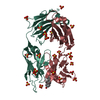
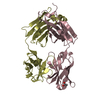
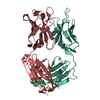
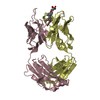
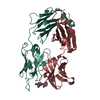
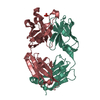
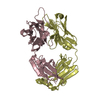
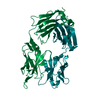
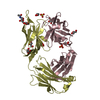
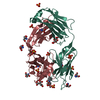
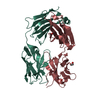


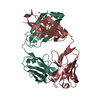
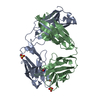


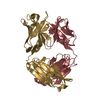
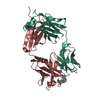

 PDBj
PDBj


